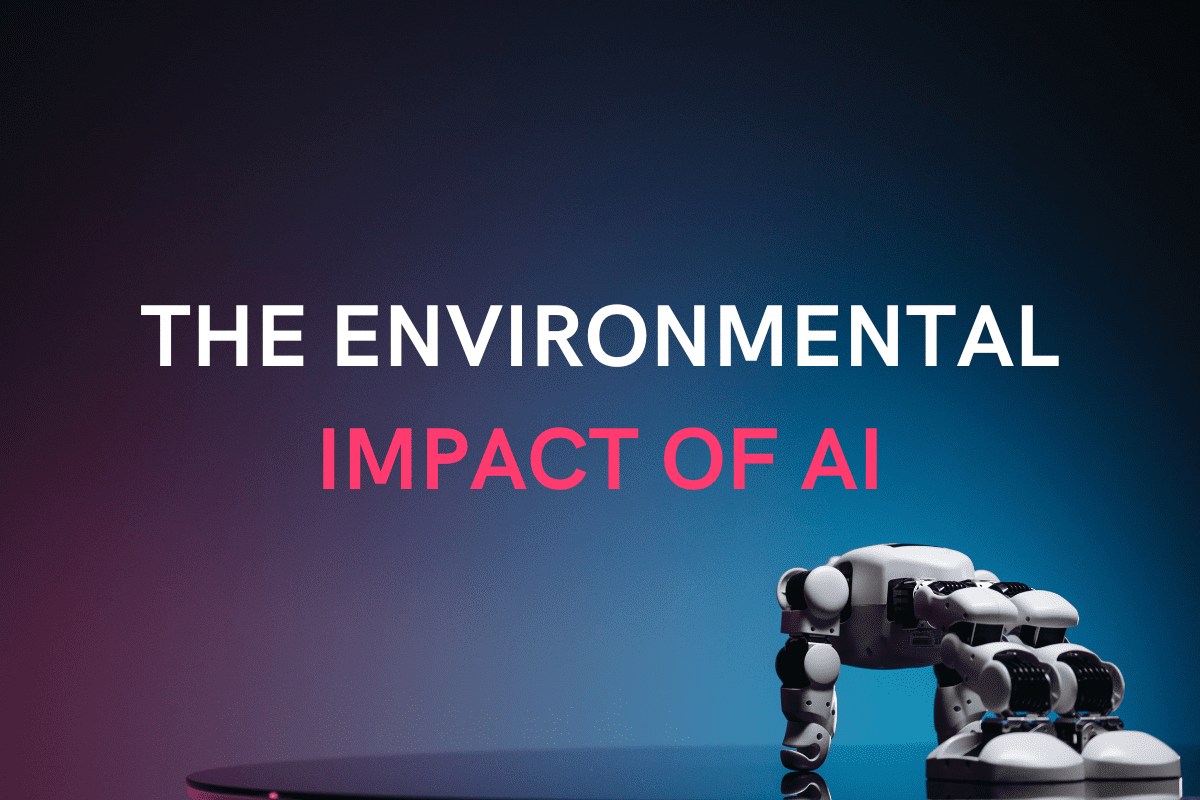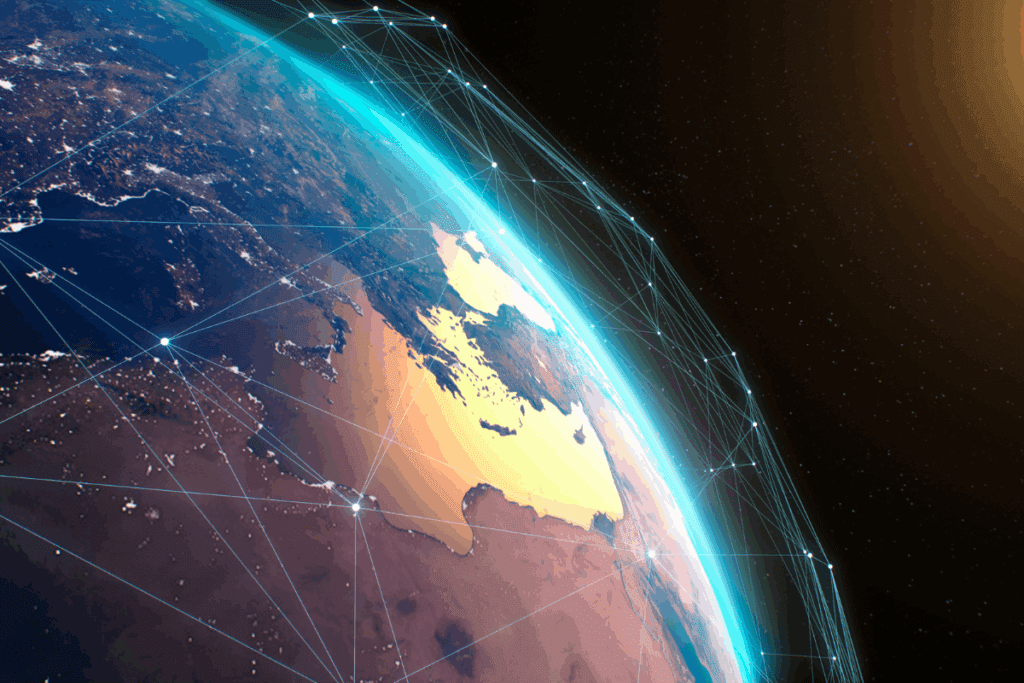
At Solve, we believe in being honest about both sides of the story. That’s why we’ve put together this comprehensive guide to help you understand the environmental impact of AI – the good, the challenging, and everything in between.
Table of Contents

Introduction- Understanding AI’s Environmental Footprint
Artificial intelligence is transforming our world at breakneck speed, but there’s a side to this digital revolution that doesn’t make the headlines quite as often. Behind every ChatGPT query, every AI-generated image, and every smart recommendation lies a hidden environmental cost that’s bigger than you might think.
AI systems can consume the equivalent energy of 120 homes per year, data centres gulp down 1.7 billion gallons of water annually, and have carbon footprints to rival entire countries.
But it’s not all doom and gloom.
The same technology that’s causing these environmental challenges is also being deployed to solve some of our planet’s biggest problems, from predicting climate disasters to optimising renewable energy grids.
Whether you’re a business leader making decisions about AI adoption, a tech enthusiast curious about sustainability, or simply someone who wants to understand what’s really happening behind the scenes of our digital world, this guide about AI’s environmental impact will give you the clear, practical insights you need.
Understanding AI’s Environmental Footprint
As AI adoption explodes and there are more data centres around the world than ever, understanding this footprint is essential for anyone making decisions about our digital future.
When considering the environmental impact of AI, your AI query is just a tiny fraction of what’s happening underneath. It’s not just the electricity involved when firing up ChatGPT, but everything from the mining of rare earth metals for computer chips to the massive cooling systems keeping data centres from overheating.
The real environmental cost includes training these AI models (which can take months and consume enormous amounts of energy), running them 24/7 in global data centres, manufacturing the specialised hardware they need, and even disposing of old equipment.
The Hidden Costs of AI Development
The real environmental impact of AI starts long before you type your first prompt.
Training a single large AI model like GPT-3 requires the equivalent energy of 552 tons of CO2 emissions – that’s roughly the same as 300 round-trip flights between New York and San Francisco.
But even that’s just the beginning.
When you take a proper life cycle view – from the moment someone decides to dig up lithium for a server’s components to the day that server gets recycled (or more likely, dumped) – the true environmental footprint becomes significantly larger than most estimates suggest.
What is AI’s Environmental Impact?
AI’s environmental impact is essentially the ecological price we pay for all that digital intelligence. At its core, it’s about three main things:
- Massive energy consumption
- Significant water usage
- Resource depletion
The challenge is that right now, the technology is growing so fast that we’re struggling to keep up with measuring and managing its environmental footprint.
1. AI Energy Consumption and Carbon Emissions
This is where AI’s environmental impact really hits home – and the numbers are genuinely staggering.
This technology is so energy-hungry it’s reshaping global electricity demand, with some AI training processes consuming more power in a few months than entire towns use in a year.
The carbon emissions follow suit, and when you consider that the computational power needed for cutting-edge AI models has been doubling every 3.4 months since 2012, we’re looking at an exponential problem that’s only getting bigger.
2. Water Usage and Resource Depletion
But AI doesn’t just devour electricity; it also guzzles water at an astonishing rate.
All those powerful servers generate serious heat, and keeping them cool requires enormous amounts of water – Microsoft alone consumes 1.7 billion gallons in a single year, a 34% jump largely driven by AI research.
Globally, data centres (which are expanding rapidly to meet AI demand) consume about 560 billion litres of water annually, a figure projected to double by 2030 as AI workloads increase and global temperatures rise
Many new data centres are being built in areas with high levels of water scarcity, increasing the risk of local shortages and competition with the needs of local communities and agricultural requirements.
It’s a stark reminder that our digital world has very real, physical consequences.
3. Resource Depletion
Smartphones alone contain dozens of elements from across the globe, and advanced AI takes this complexity to another level entirely.
AI hardware depends on a complex mix of common materials like aluminium, silicon and copper, alongside more specialised elements including gallium, germanium, palladium and neodymium. These rare elements are all essential for the high-performance processors, advanced cooling systems, and rapid data transmission that modern AI demands.
The environmental cost of extracting these materials is significant – mining operations can contaminate local water supplies, destroy habitats, and even displace entire communities.
What makes this particularly challenging is that many of these critical minerals come from just a handful of locations worldwide, creating supply chain vulnerabilities and often putting extraction in areas with limited environmental protections.
As AI demand skyrockets, we’re essentially racing to dig up increasingly remote and ecologically sensitive areas to feed our appetite for digital intelligence.

The Positive Side: AI for Environmental Solutions
However, it’s not all negative. AI can also be used as a force for good.
The same technology that’s causing these challenges is also emerging as one of our most powerful tools for tackling climate change and environmental problems. Many experts believe that with thoughtful regulation, investment in green energy, and smarter, more efficient AI design, we can harness AI’s benefits while minimising its environmental footprint.
AI’s ability to process vast amounts of data and make predictions with remarkable accuracy is already helping us understand and protect our planet in ways we never could before. The key is to balance innovation with responsibility, ensuring that AI becomes a tool for sustainability rather than a new source of ecological stress.
Yes, there are (serious) issues to address, but the potential to save lives is enormous.
Climate Modelling and Prediction
AI is revolutionising how we understand and predict our changing climate, and frankly, it couldn’t come at a better time.
Traditional climate models, while impressive, can struggle with the sheer complexity of our planet’s systems – there are simply too many variables for conventional computing to handle effectively.
AI can analyse massive datasets from satellites and weather stations to create far more accurate climate projections than ever before. Machine learning algorithms can predict extreme weather events weeks in advance, giving communities crucial time to prepare.
AI is also helping scientists understand complex climate phenomena like cloud formation and ocean currents that have puzzled researchers for decades. The result? Better early warning systems for hurricanes, floods, and heat waves that are already saving lives and reducing economic damage.
Renewable Energy Optimisation
The challenge with renewable energy has always been its unpredictability: the wind doesn’t blow on schedule, and clouds have a habit of appearing just when you need sunshine most.
Smart algorithms can forecast wind speeds days in advance, helping wind farms maximise their output, while machine learning systems optimise solar panel positioning throughout the day.
AI can make our clean energy systems work smarter, not just harder. It can manage entire smart grids, automatically switching between different energy sources and storing excess power when it’s abundant.
A McKinsey report highlighted by Equans states that AI-driven technologies can help businesses reduce their CO₂ emissions by up to 10% and cut energy costs by 10-20%. Some studies suggest AI could help reduce global greenhouse gas emissions by up to 4% through energy optimisation alone.
Environmental Monitoring and Conservation
Satellite imagery powered by machine learning can spot illegal deforestation in real-time, track wildlife migration patterns, and even identify individual animals for conservation research.
- AI-powered camera traps in rainforests that can distinguish between different species and alert rangers to poaching activities instantly
- In our oceans, AI is helping track plastic pollution, monitor coral reef health, and guide cleanup efforts like the Ocean Cleanup project
- AI systems can now process years of satellite data in hours, revealing environmental changes and trends that might have taken scientists decades to identify manually.
Smart Agriculture and Resource Management
Feeding a growing global population while reducing environmental impact is one of our biggest challenges.
AI-powered precision farming is already helping farmers use resources more efficiently, from optimising irrigation systems that deliver exactly the right amount of water to specific crop areas, to AI-driven tractors that can identify and target individual weeds, reducing pesticide use.
Machine learning algorithms analyse soil conditions, weather patterns, and crop health to predict optimal planting times and harvest windows, maximising yields while minimising environmental impact.
AI is also revolutionising livestock management, monitoring animal health and behaviour to reduce waste and improve welfare.
The technology is even helping tackle food waste – AI systems can predict demand more accurately, optimising supply chains and reducing the enormous environmental cost of food that never makes it to our plates.

Industry Response and Mitigation Strategies
There’s a growing recognition that sustainable AI isn’t just good for the planet, it’s good for business too.
From Google’s carbon-neutral data centres to Microsoft’s ambitious water reduction targets, we’re seeing major players invest billions in making AI more environmentally responsible.
The pressure is coming from multiple directions: investors demanding ESG accountability, governments introducing stricter regulations, and increasingly environmentally conscious consumers.
What’s encouraging is that many of these initiatives are moving beyond green PR to deliver real, measurable improvements in how AI systems are developed and deployed.
Tech Companies Taking Action
The big tech companies are rolling out increasingly ambitious environmental strategies, and the results are starting to show.
- Microsoft has committed to being carbon negative by 2030 and has already reduced its water consumption intensity by implementing advanced cooling technologies and AI-optimised data centre management (though they’re still grappling with that 34% increase in overall water usage driven by AI research).
- Google has been carbon neutral since 2007 and achieved carbon neutrality for its entire operation, with its data centres now 50% more energy efficient than the industry average thanks to AI-powered cooling systems and renewable energy investments.
- Amazon is on track to power its operations with 100% renewable energy by 2025, five years ahead of schedule, while investing $10 billion in climate projects through its Climate Pledge Fund.
- OpenAI has partnered with Microsoft to develop more efficient AI models and is researching ways to reduce the computational requirements of training large language models.
- Meta (formerly Facebook) has committed to achieving net-zero emissions across its value chain by 2030 and is investing heavily in renewable energy projects.
- Even NVIDIA, whose chips power much of the AI revolution, is working on more energy-efficient architectures and has committed to carbon neutrality by 2025.
What’s particularly encouraging is seeing smaller companies like Solve prove that sustainable web practices can make a real difference, even at the SME level. The production and running of digital technologies by all internet users around the world accounts for 1.7 billion tonnes of greenhouse gas emissions annually. Our green hosting solutions can help company websites save more CO2 than a return flight from London to Barcelona.
Lawrence Harmer, founder of Solve, says,
“We can’t sit back and wait for the internet to become net zero – it’s today’s emissions that cause tomorrow’s climate change. We all need to take full responsibility for our digital carbon footprint today and change our internet habits now for the future.”
Energy-Efficient AI Development
The race is on to make AI smarter about how it uses energy, and the innovations coming out of research labs are genuinely impressive.
- Model compression techniques are allowing developers to create AI systems that perform nearly as well as their larger counterparts while using a fraction of the computational power. Pruning algorithms can remove unnecessary neural network connections, reducing model size by up to 90% in some cases while maintaining performance.
- Edge computing is another game-changer, moving AI processing closer to where data is generated rather than sending everything to energy-hungry data centres. Companies like Apple are leading this charge with their Neural Engine chips that handle AI tasks directly on devices.
- Quantisation techniques are reducing the precision of calculations without significantly impacting results, cutting energy consumption dramatically.
- Perhaps most promising are neuromorphic chips that mimic how the human brain processes information, potentially reducing AI energy consumption by orders of magnitude.
- Software innovations like federated learning allow AI models to be trained across multiple devices without centralising data, reducing the need for massive data centre operations.
Renewable Energy Adoption
The shift to renewable energy in AI infrastructure is accelerating rapidly, driven by both environmental concerns and increasingly favourable economics.
Whilst the trikes of Google and Amazon are displaying efforts to minimise the environmental impact of AI, what’s particularly encouraging is seeing renewable energy adoption extend beyond the tech giants. Digital Realty, one of the world’s largest data centre operators, has committed to carbon neutrality by 2030 and is helping smaller AI companies access renewable energy through their facilities.

Measuring and Quantifying AI’s Environmental Impact
The frustrating truth is that we’re making massive decisions about AI deployment based on incomplete environmental data. Without accurate data, we can’t make informed trade-offs between AI’s benefits and its environmental costs, leaving both businesses and policymakers flying blind on one of the most important technology decisions of our time.
Current Challenges in Assessment
The biggest problem is that there’s currently no standardised way to measure AI’s environmental impact, leading to wildly different estimates for similar systems.
OpenAI hasn’t disclosed training details for GPT-4, making it “impossible to estimate emissions” according to AI ethics researchers, while other companies cherry-pick the most favourable metrics for their reporting.
Life cycle assessments for AI systems are particularly challenging because they need to factor in everything from chip manufacturing in Taiwan to server cooling in Iceland, with each stage involving different environmental impacts and measurement methodologies.
The Need for Better Data
The data gap is enormous and getting worse as AI systems become more complex and distributed across global infrastructure.
We need real-time monitoring systems that can track energy consumption, water usage, and carbon emissions at the individual model level, not just at the data centre level.
Industry standardisation is crucial – we need consistent methodologies for measuring training costs, inference costs, and infrastructure impacts that allow meaningful comparison between different AI approaches.
Until we have this granular, standardised data, we’re essentially making environmental policy in the dark, which isn’t sustainable when AI’s impact is growing exponentially.
Emerging Measurement Frameworks
The AI Green Index is emerging as a promising standardised framework for evaluating both carbon and water footprints across AI lifecycles, offering the kind of unified metric that the industry desperately needs. By implementing this index, stakeholders can better understand and mitigate the environmental impact across the entire life cycle of AI applications.
Future Outlook and Sustainable AI Development
The next decade will be make-or-break for sustainable AI – we’re at a crossroads where the decisions made today will determine whether AI becomes an environmental solution or an escalating problem.
Emerging technologies and changing industry practices could dramatically alter this trajectory. The encouraging news is that sustainability is moving from an afterthought to a core design principle, driven by both regulatory pressure and the simple economic reality that energy-efficient AI is often more profitable AI.
Industry Projections and Trends
The computational efficiency of AI models is improving by roughly 10x every 18 months, meaning future AI systems should deliver dramatically more capability per unit of energy consumed.
Liquid cooling systems and immersion cooling technologies are increasingly replacing traditional air conditioning in data centres, driven by the need for greater energy efficiency and support for high-density computing.
Advanced materials like graphene-based processors and optical computing could eliminate much of the heat generation that drives current energy consumption.
| Cooling Method | Energy Savings vs. Air | Key Benefits | Adoption Trend |
| Liquid Cooling | Up to 40% | Supports high-density racks, lower PUE, compact | Rapidly increasing |
| Immersion Cooling | Highly targeted | Eliminates room-wide AC, compact, efficient | Growing adoption |
| Traditional Air | Baseline | Simpler, but less efficient for modern loads | Being replaced |
This is hopefully all moving in the right direction, but is it enough to counteract the environmental impact of AI on our planet?
The environmental impact of AI isn’t just a problem for tech giants to solve – we all have a role to play, and the choices we make as consumers and businesses can drive real change across the industry.
Taking Action: What Organisations and Individuals Can Do
The good news is that being more responsible with AI often means being more efficient and cost-effective too, making this one of those rare win-win situations where doing the right thing also makes commercial sense.
How to Be a More Responsible AI Consumer
- Choose your queries wisely – AI systems consume 4-5 times more energy than traditional search engines, so asking ChatGPT to write your grocery list when a simple note would do is wasteful. Save AI for tasks that genuinely benefit from its capabilities, like complex analysis or creative problem-solving that would be difficult or time-consuming for humans.
- Opt for text over images when possible – generating AI images consumes significantly more energy than text responses, with some image generation tasks using as much power as fully charging your smartphone. If you’re experimenting with AI art tools, try to batch your requests rather than generating dozens of iterations for minor tweaks.
- Support companies with transparent environmental policies – choose AI services from providers who publish their carbon footprint data and commit to renewable energy. Companies like Google and Microsoft provide detailed sustainability reports, while others remain frustratingly opaque about their environmental impact.
- Use AI tools efficiently – instead of starting from scratch each time, build on previous conversations, save useful responses, and share effective prompts with colleagues to reduce redundant AI processing. Many people generate the same basic content repeatedly, whereas a little organisation could eliminate unnecessary consumption.
- Consider local and edge-based AI when available – tools that run on your device (like Apple’s Siri or offline translation apps) typically have a much smaller environmental footprint than cloud-based alternatives (though they may be less powerful).
Corporate AI Sustainability Strategies
- Integrate environmental impact assessments into your AI procurement decisions – evaluate potential AI tools not just on functionality and cost, but on their energy consumption and the sustainability commitments of their providers.
- Implement AI governance frameworks that include mandatory environmental considerations for any new AI deployment. Set clear guidelines about when AI is appropriate versus when simpler, less energy-intensive solutions would suffice.
- Choose green hosting and cloud providers – if you’re building AI applications, select infrastructure providers committed to renewable energy. Green hosting solutions can significantly reduce your digital carbon footprint while often delivering better performance.
- Train your teams on efficient AI usage – many people use AI inefficiently simply because they don’t understand the environmental implications. Basic awareness training can dramatically reduce unnecessary consumption while improving results.
Conclusion: Balancing AI Innovation with Environmental Responsibility
We stand at a pivotal moment in technological history where our choices about AI development and deployment will shape both our digital future and our planet’s health for generations to come.
As consumers, developers, and decision-makers, we have the power to drive this transition through every choice we make, every vendor we select, and every conversation we have about what responsible technology looks like. Do you really need to use AI to make that action figure of yourself in toy packaging?
Ultimately, the future of AI is not only about capability, but responsibility. The environmental cost of getting this wrong is too high, but the potential benefits of getting it right could be transformational.
Working together responsibly, our planet’s future can be brighter.

Frequently Asked Questions about The Environmental Impact of AI
How much energy does a single ChatGPT query actually use?
A single AI query consumes approximately 4-5 times more energy than a traditional Google search. While the exact figures vary, generating a simple text response uses roughly the same energy as a 60-watt light bulb running for about 10 minutes.
Is AI worse for the environment than other technology?
AI isn’t inherently worse than other technologies, but it’s growing so rapidly that its environmental impact is accelerating faster than most other digital services. Data centres already account for 1-2% of global electricity consumption, and AI workloads can be 7-8 times more energy-intensive than traditional computing tasks.
Can AI actually help solve climate change despite its environmental impact?
Absolutely. AI applications could reduce global greenhouse gas emissions by up to 4% through energy optimisation, climate modelling, smart agriculture, and renewable energy management.
Are tech companies doing enough to address AI’s environmental impact?
Many companies still lack transparency about their AI-specific environmental impacts, and the rapid growth of AI is often outpacing efficiency gains. The industry needs standardised environmental reporting and more aggressive sustainability targets to keep pace with AI’s expanding footprint.
What can I do as a consumer to reduce AI’s environmental impact?
Use AI thoughtfully – save it for tasks that genuinely benefit from its capabilities rather than simple queries that traditional search could handle. Choose text responses over image generation when possible. Consider using edge-based AI tools that run on your device when available, as these typically have smaller environmental footprints than cloud-based alternatives.
Why is AI considered a potential climate disaster?
The “disaster” narrative stems from AI’s exponential growth combined with its massive resource requirements. The computational power needed for cutting-edge AI models has been doubling every 3.4 months since 2012, leading to exponential increases in energy consumption. By 2027, AI could consume 85-134 terawatt hours annually, nearly 0.5% of all global electricity usage. What makes this particularly concerning is that this growth is outpacing efficiency improvements and renewable energy adoption.
Is ChatGPT really worse than Google search for the environment? Yes, significantly.
A single ChatGPT query consumes roughly 10 times more electricity than a Google search (2.9 watt-hours vs 0.3 watt-hours). However, this comparison isn’t entirely fair since AI can often provide more comprehensive answers that might replace multiple traditional searches.





